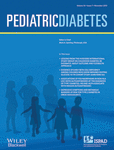Vascular function and glucose variability improve transiently following initiation of continuous subcutaneous insulin infusion in children with type 1 diabetes
Abstract
Objective
The effect of continuous subcutaneous insulin infusion (CSII) and glucose variability on vascular health in type 1 diabetes (T1D) is not known. We aimed to determine whether initiation of CSII improves vascular function and reduces glucose variability, independent of changes in HbA1c.
Methods
Twenty-two children with T1D (12.5 ± 2.9 yr) were reviewed immediately prior, 3 wk, and 12 months after initiation of CSII. Vascular function [flow-mediated dilatation (FMD), glyceryl trinitrate-mediated dilatation (GTN)], glucose variability [mean of daily differences (MODD), mean amplitude of glycaemic excursions (MAGE) and continuous overlapping net glycaemic action (CONGA)], and clinical and biochemical data were measured at each visit. Results for the first two visits were compared to a previously studied cohort of 31 children with T1D who remained on multiple daily injections (MDI).
Results
FMD, GTN, blood pressure, HbA1c, fructosamine, and glucose variability significantly improved 3 wk after CSII commencement (all p < 0.05), but there was no change in the MDI control group. At 3 wk, vascular function related to glucose variability [(FMD: MODD, r = −0.62, p = 0.002) and (GTN: MAGE, r = −0.59, p = 0.004; CONGA-4, r = −0.51, p = 0.01; MODD, r = −0.62, p = 0.002)] but not to blood pressure, HbA1c, or fructosamine. At 12 months, FMD, GTN, blood pressure, and glucose variability returned to baseline levels, while HbA1c deteriorated. Carotid intima media thickness was unchanged over 12 months.
Conclusions
Initiation of CSII rapidly improves vascular function in association with decreased glucose variability; however, the effects are not sustained with deterioration of metabolic control and glucose variability.




